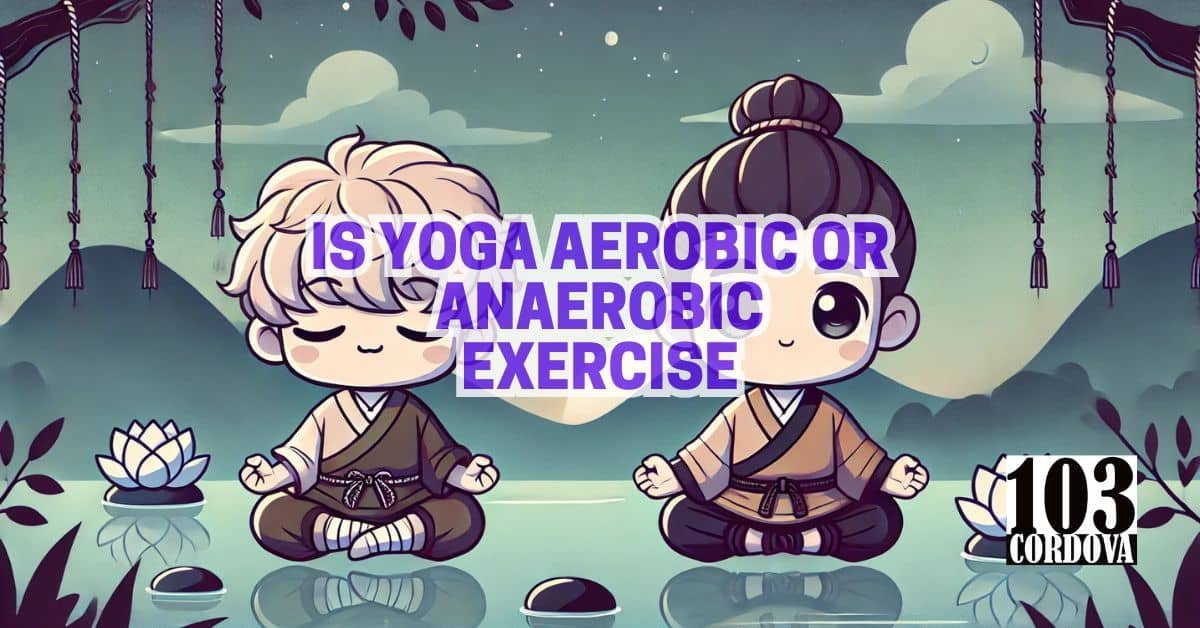Yoga is often associated with improving flexibility, mental well-being, and strength, but its classification as aerobic or anaerobic exercise is less clear.
Understanding this distinction can help individuals tailor their fitness routine to meet specific goals like weight loss, strength building, or cardiovascular health.
While some yoga styles involve fast-paced sequences that raise the heart rate, others focus on slow, controlled movements.
Determining if yoga is aerobic or anaerobic depends largely on the type of practice and its intensity.
We’ll compare yoga to traditional forms of exercise, outlining how it fits into both aerobic and anaerobic categories.
1. Understanding Aerobic and Anaerobic Exercise: Definitions and Differences
Aerobic exercise involves sustained, rhythmic movements that keep the heart rate elevated over a prolonged period.
Running, cycling, and swimming are prime examples of aerobic activities that rely on oxygen for energy production.
Anaerobic exercises, like weightlifting or sprinting, consist of short bursts of intense effort where the body’s energy systems do not rely on oxygen.
These two types of exercise target different energy systems and yield distinct benefits—cardiovascular endurance in aerobic workouts and muscle strength and power in anaerobic.
By understanding these differences, it becomes easier to see how yoga incorporates aspects of both.
🧘 Is Power Yoga Aerobic or Anaerobic? Understanding Its Health Effects
2. Exploring Various Yoga Practices: Types and Intensity Levels
Yoga comes in many forms, and each style varies in intensity and physical demand.
Gentle styles like Hatha Yoga emphasize slow movements and stretching, making them more akin to low-intensity aerobic exercises.
On the other hand, vigorous practices like Power Yoga or Ashtanga Yoga involve continuous movement and strength-based poses, which can elevate the heart rate and engage anaerobic energy systems.
The wide variety of yoga practices makes it difficult to classify the activity under a single label.
Whether a session feels aerobic or anaerobic largely depends on the intensity and pace of the specific practice.
🧘 Is Hot Yoga Aerobic or Anaerobic? Effects on Your Body
3. Energy Systems in Yoga: How It Engages Aerobic and Anaerobic Pathways
Yoga primarily engages the aerobic system when the movements are slow, steady, and accompanied by controlled breathing.
This is similar to how aerobic exercises work, by relying on oxygen to fuel the body over extended periods.
However, certain styles of yoga, such as Vinyasa, require rapid transitions between poses that demand bursts of energy, triggering anaerobic pathways.
Holding challenging poses, like planks or handstands, also activates anaerobic energy systems as muscles work intensely without oxygen.
Depending on the intensity and type of yoga, both aerobic and anaerobic systems can be engaged at different points throughout a session.
🧘 How Yoga Transforms Lives Through Mindfulness
4. Heart Rate and Intensity: Yoga Compared to Traditional Workouts
Traditional aerobic exercises like running or cycling are designed to keep the heart rate elevated within a target zone for extended periods, optimizing cardiovascular fitness.
In comparison, yoga, particularly slower forms like Hatha, tends to maintain a lower heart rate throughout the session.
Faster practices like Vinyasa or Power Yoga can raise the heart rate, but often not as high as traditional aerobic workouts.
However, these dynamic styles can still improve heart health through moderate intensity.
Overall, yoga provides more variability in heart rate, depending on the style and pace, making it a more flexible option for different fitness goals.
🧘 Preparing for Your First Yoga Class in Marikina: A Guide for Beginners
5. Flexibility and Strength: How Yoga Differs from Strength Training
Yoga emphasizes flexibility, balance, and bodyweight strength through sustained poses and stretching, but it doesn’t focus on hypertrophy or muscle growth like strength training.
In traditional anaerobic workouts, weights or resistance bands are used to overload muscles, aiming for increased muscle mass and strength.
Yoga’s strength benefits come more from endurance and stability, especially when holding challenging postures for longer durations.
While strength training isolates muscle groups, yoga engages the entire body, enhancing both core stability and flexibility.
This makes yoga a complementary practice to anaerobic strength training rather than a direct replacement.
🧘 Who Wrote the Yoga Sutras? Exploring Its Historical Significance
6. Caloric Burn: Comparing Yoga to Aerobic and Anaerobic Exercises
Aerobic exercises, such as running or high-intensity interval training (HIIT), typically burn more calories in a shorter time compared to yoga.
Most slower yoga styles, like Yin or Hatha, are low-intensity and burn fewer calories per session.
However, faster styles like Power Yoga or Ashtanga, which include continuous movements and strength-based poses, can increase caloric burn, bringing it closer to moderate-intensity aerobic workouts.
In comparison to anaerobic exercises like weightlifting, yoga burns fewer calories overall but offers a longer workout that combines strength, flexibility, and mindfulness.
For those aiming for higher calorie expenditure, intense yoga styles can provide a middle ground between aerobic and anaerobic activities.
🧘 When Was Yoga Invented? The Ancient Origins of This Practice
7. Mental Health Benefits: Yoga Versus Traditional Workouts
Yoga is widely recognized for its positive effects on mental health, often integrating mindfulness, breath control, and meditation into physical practice.
These components make yoga particularly effective for reducing stress, improving mood, and promoting mental clarity.
While traditional workouts, like running or strength training, can also boost mood through endorphin release, they often lack the specific focus on mental and emotional well-being that yoga provides.
Practices like Pranayama (breathing exercises) help calm the mind, which is less common in traditional workout routines.
Yoga’s holistic approach to health makes it a powerful tool for both physical and mental wellness, offering unique benefits beyond traditional fitness regimes.
🧘 What Are Yoga Pants? A Guide to Comfort and Style
8. Injury Prevention: The Role of Yoga in Rehabilitation
Yoga is frequently recommended for injury rehabilitation due to its gentle, low-impact nature.
Its emphasis on controlled movements and flexibility helps strengthen muscles and improve range of motion without putting undue strain on the body.
Unlike high-intensity anaerobic exercises, which can sometimes exacerbate injuries, yoga supports gradual recovery by targeting muscle imbalances and enhancing joint stability.
Poses can be modified to accommodate injuries, making yoga a safe and effective option for those in recovery.
In addition, yoga’s focus on mindfulness and body awareness can prevent future injuries by improving posture and movement patterns.
🧘 What Are Yoga Sutras? A Beginner’s Introduction to Ancient Wisdom
9. Accessibility of Yoga: Meeting Various Fitness Levels
One of the major advantages of yoga is its adaptability to different fitness levels, making it accessible to beginners, seniors, and athletes alike.
Gentle forms of yoga, such as restorative or chair yoga, are ideal for people with limited mobility or those recovering from injury.
More advanced practitioners can engage in physically demanding styles like Power Yoga or Ashtanga, which challenge strength and stamina.
This flexibility in intensity and difficulty allows individuals to choose a yoga practice that aligns with their fitness level and goals.
Yoga’s accessibility makes it an inclusive form of exercise that can evolve as fitness levels change.
🧘 What Are Yoga Blocks For? Enhancing Your Practice with Props
10. Balancing Yoga and Traditional Workouts for Optimal Fitness
Incorporating both yoga and traditional workouts into a fitness routine can provide a balanced approach to physical health.
Yoga enhances flexibility, mindfulness, and body weight strength, while traditional aerobic and anaerobic exercises build cardiovascular endurance and muscle mass.
For those seeking a well-rounded routine, yoga offers recovery and injury prevention benefits that complement the intensity of strength and cardio training.
Alternating between these workouts ensures that both flexibility and strength are developed, reducing the risk of overuse injuries and promoting overall fitness.
This combination offers the best of both worlds for a holistic approach to health.
🧘 The Benefits of Yoga: Insights from Scientific Research
💡 Conclusion
Yoga engages both aerobic and anaerobic systems depending on the style, pace, and intensity of the practice.
While slower forms of yoga may align more closely with aerobic activity, vigorous practices can incorporate elements of anaerobic strength training.
Ultimately, yoga is difficult to classify as purely aerobic or anaerobic, as it occupies a unique space that blends flexibility, mindfulness, and moderate strength.
For optimal fitness, yoga is best combined with more traditional aerobic and anaerobic exercises.
This mix provides a well-rounded approach to physical and mental well-being, making yoga a valuable addition to any fitness regimen.
🧘 Our Services
Experience the benefits of yoga at our studio, offering classes for all ages and fitness levels.
Conveniently located at 103 Cordova Tower, Marquinton Residences, Sto. Nino, Marikina City, we provide a welcoming environment for beginners and experienced practitioners alike.
Whether you’re looking to improve flexibility, reduce stress, or build strength, our certified instructors are here to guide you.
For more information, contact us at 09176225780, message us on Facebook, or use the contact form on our website.
Join us today and start your journey to better health and well-being!

